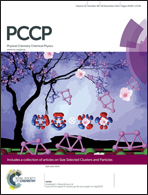Achieving balanced intermixed and pure crystalline phases in PDI-based non-fullerene organic solar cells via selective solvent additives†
Abstract
Herein, balanced intermixed and pure crystalline phases in N,N′-bis(1-ethylpropyl)-perylene-3,4,9,10-tetracarboxylic diimide (EP-PDI)-based non-fullerene organic solar cells (OSCs) were achieved via selective solvent additives (SAs). Poly[[4,8-bis[(2-ethylhexyl)oxy]benzo[1,2-b:4,5-b′]dithiophene-2,6-diyl][3-fluoro-2-[(2-ethylhexyl)carbonyl]thieno[3,4-b]thiophenediyl]] (PTB7) and 7,7′-(4,4-bis(2-ethylhexyl)-4H-silolo[3,2-b:4,5-b′]dithiophene-2,6-diyl)bis(6-fluoro-4-(5′-hexyl-[2,2′-bithiophen]-5-yl)benzo[c][1,2,5]thiadiazole) (F-DTS) possessing different compatibilities with EP-PDI were selected as model systems to investigate the guideline of SAs selection for different non-fullerene-based systems. According to the solubility parameter difference (Δδ) between EP-PDI and SAs, five different SAs were divided into two types: (I) strong intermolecular interactions with EP-PDI molecules (with Δδ values less than 5 MPa1/2), (II) weak intermolecular interactions with EP-PDI molecules (with large Δδ values). For PTB7:EP-PDI system with large and obvious phase separation, the introduction of type (II) SAs provided extra interactions with EP-PDI molecules, thus effectively reducing EP-PDI aggregate domains and increasing intermixed fractions. The incorporation of type (II) SAs resulted in a greater yield of dissociated polarons, and the final device efficiency increased from 0.02% to 1.65%. On the contrary, for finely mixed F-DTS:EP-PDI systems, type (I) SAs were considerably more effective because of the fact that the required pure crystalline phases were readily induced by the unfavorable interactions. The charge transport pathways optimized by type (I) SAs improved device efficiency from 0.18% to 2.82%. Hence, by processing selective SAs, the fraction of intermixed and pure crystalline phases for PDI-based non-fullerene OSCs can be well regulated; therefore, the final performance for both systems can be significantly improved.


 Please wait while we load your content...
Please wait while we load your content...